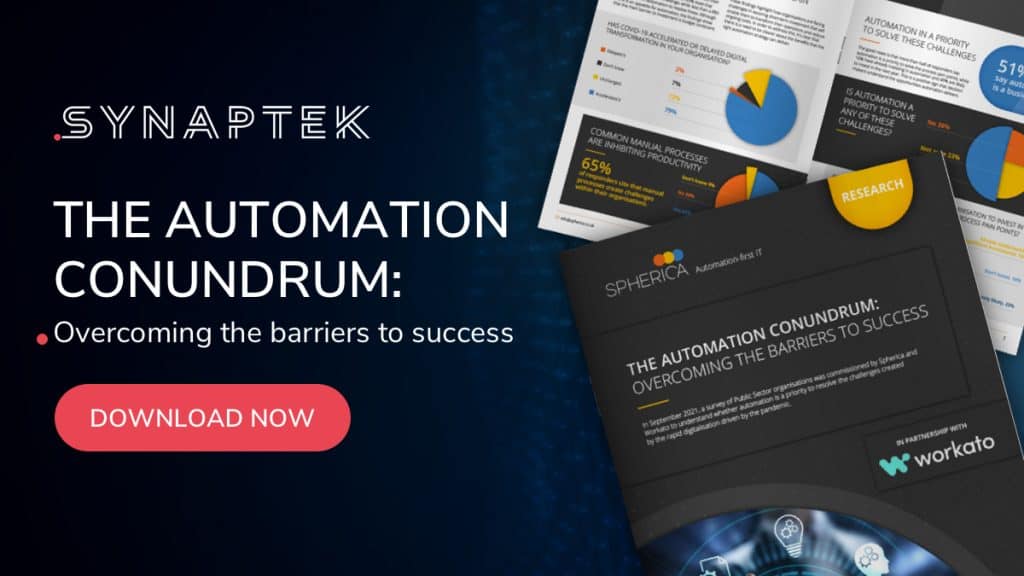With automation being such a hot topic, we need to address the barriers to automation success…
Process automation is one of the hottest topics because of the opportunities it brings to aid post-Covid recovery, help counter cybersecurity risks and facilitate better citizen engagement.
However, research we recently commissioned in association with Public Sector Executive found that although automation is on the agenda for over 90% of organisations, few have actually invested in the technology.
Download the full research report here, and read on for the key findings and tips on how to overcome the barriers preventing automation success.
Accelerated Digitalisation

It comes as no surprise that 79% of responders have seen their digital transformation investments accelerated by the impact of the pandemic – news outlets have been saturated with similar stats since the early days of the national lockdown.
However, what may come as a surprise is the disparity between the appetite for automation and the speed of investment. This is what we’ve called The Automation Conundrum.

The results of the research show that 93% of survey responders have automation on their agenda, yet only 28% have implemented any automation technology and a 33% don’t yet have a strategy.
This demonstrates how the appetite for automation has not yet converted into widescale adoption.
Common process pain points
The findings also identify common challenges that impact teams and performance, which the right automation and integration strategy can address:
- Siloed systems and processes. 63% cite a lack of system integration as a hindrance to work, while 61% say siloed processes are an issue
- Legacy systems. 56% of respondents cite legacy systems as a barrier to change
- Lack of skills. 63% of respondents say a shortage of skills is impacting the success of their digital transformation initiatives

While this shows that there are common challenges faced by Public Sector organisations, there is also a collective mindset that automation can address these pain points, with over 50% of respondents citing automation as the solution to overcoming their digital transformation challenges.
However, identifying and addressing the barriers that have prevented investment to date is key to avoiding costly mistakes.
Barriers to change
The research identifies two key barriers to automation investment:
- Lack of awareness and understanding of the technology available
More than 50% of respondents weren’t aware of any automation technologies referenced in the survey. This included much hyped technologies, such as Robotic Process Automation (RPA).
Automation is a complex topic and increasing understanding of the benefits and constraints of the options available is key to choosing the right solution for your organisation.
- Budget constraints
38% cited cost as the biggest barrier, so there needs to be a mindset shift to understand that short term investment will deliver long term benefits and cost savings. The best way to demonstrate this is to start small and prove the value before making significant investments.
Based on this lack of understanding, Public Sector organisations need to be looking for technology partners who can simplify the complexity of the task and ensure their automation strategy is tailored to their long term goals. This is where services like ours come in to their own.
Steve Jennings, Managing Director, Spherica, explains, “Automation will prove a saviour in post-Covid recovery, but only if it is better understood, pragmatically planned and the right strategies are implemented.”
The journey to automation success
Here are four practical steps to beginning your journey to a successful automation strategy.
- Identity your needs and define your long term goal
Before you embark on a full-scale automation strategy, you need to understand where you are and where you need to be on the Automation Maturity Model.

At the bottom end are simple automations designed to solve immediate process issues and usually driven by the needs of an individual team. It is usually point to point or system to system automation and is unlikely to be scalable. At the opposite end is data driven automation that is designed to support the strategic goals of the organisation and adapts and learns as it consumes more data, enabling scale.
Review your current position, documenting your technology stack, data sources and the processes that would benefit from automation.
Remember, you don’t want to automate an inefficient process as this will only act as a short term sticking plaster that will eventually become unstuck. In order to ensure your investment in process automation delivers long-term returns, you first need to identify and fix the inefficiencies in the processes and then apply automation to magnify these efficiencies.
- Prove the value
As the saying goes, don’t try to boil the ocean! Start with low hanging fruit to demonstrate the value, choosing use cases that can be replicated and which build the foundations to more wide scale process automation.
The following checklist is a useful guide to identify the best use cases:
- Does the value outweigh the cost?
- It is repeatable and scalable?
- What will have the least resistance?
- Map outcomes
Outcome mapping sets out the steps to evaluating whether you achieve the outcome you want. Define the short and long-term impact of the change so that you can effectively assess the difference automation makes to your employees, your organisation and your end users.
- Engage the hearts and minds of those impacted
Like with any digital transformation or change initiative, it will only be as successful as the people embedding it. Engage those whose roles are impacted and invest in training and upskilling to ensure successful adoption.
A pragmatic approach, starting small and building on success, is the best way to achieve the right automation strategy for your individual needs.
